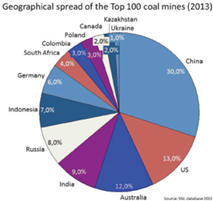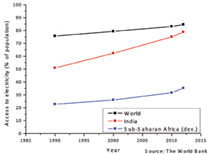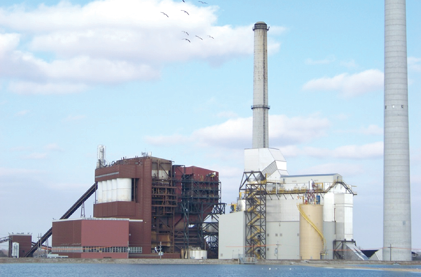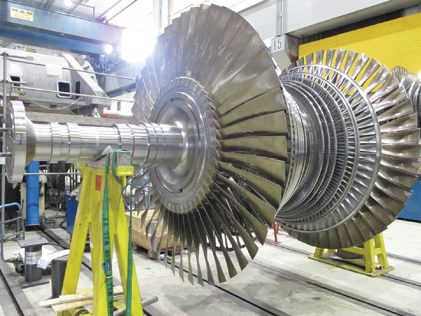Approximately 77% of world coal production is classified as thermal coal. As a consequence, this analysis will focus mainly on this aspect of the industry. In a first step, the role of renewables and coal in power generation will be analyzed. Public opinion seems to indicate that renewable sources of energy have already reached a technical maturity enabling them to replace fossil fuels.
Figure 1 provides a more realistic view of coal’s place in the global energy mix and on the substitution capabilities of renewables.
Closer inspection shows that coal is and will remain an important component in the primary energy mix for the foreseeable future. Energy consumption from renewable sources (wind, solar, biofuel and others) can be expected at least to double in the next five years based on the Compound Annual Growth Rate (CAGR) of recent years (2006-2014). The CAGR of the global energy generation was only 2.4% over the same period. This means the share of renewables will remain a single-digit percentage for the near term.
Figure 1: Coal’s role in the global energy mix.
The expansion of renewable power sources might cover future energy demand growth in developed countries and in China, and renewables might partly replace nuclear power plants in Germany and some old coal-fired power plants in the U.S. However, the use of natural gas for energy generation poses a much bigger challenge to the coal mining industry than any renewable source.
Natural gas is as abundant as coal, and gas-fired power plants have high rates of efficiency and flexibility with moderate investment costs. All this leads one to assume that coal will lose market share to natural gas rather than to renewables, especially in developed countries.
Figure 2 shows the geographical location of the 100 largest coal mines by production. They cover approximately 28% of global coal production. These are the largest and probably most effective mines globally. Looking in more detail, more than one-third of these mines are producing in Organization for Economic Cooperation and Development (OECD) member countries, among them Australia, the biggest coal exporter. However, as expected, China has the highest share of the biggest coal mines.

Figure 2: Geographical distribution of coal production at the 100 largest mines.
It is obvious that in the medium term, the geographical distribution of the largest coal mines will change significantly. Developed countries, with the exception of Australia, will cut back their coal production to meet climate policy targets. In Germany, in particular, the regulatory environment will be increasingly challenging.
As far as the future path of the global coal mining industry is concerned, however, the development of the sector in China will be of decisive importance. The core issue in the transition of the Chinese coal sector is the declining competitiveness of the domestic coal producers due to the multifaceted industrial structure, coal quality issues and the emergence of new low-cost suppliers in neighboring countries.
Additionally, the image of the industry still suffers heavily. Photos of Chinese cities in a blanket of smog have been seared into the collective memory. Coal has been named as the main reason for this misery. This has led the government to stop granting coal-mining rights until 2019.
Government interventions generally do not promote the transition toward the sustainable use of natural resources, as they are counterproductive to efforts to close small and inefficient operations across the country. Despite this, the road ahead for the Chinese coal mining industry is clear. Lean and efficient coal mines are required, and investments in the emission control of coal-fired power plants will be surely promoted by the government.
It is obvious that the coal mining sector is closely interwoven with power producers through ownership or long-term supply arrangements. This means the fate of the coal mining sector is directly dependent on the future development of the power generation sector.
Contribution to Global Development
Coal was vital for the global industrial expansion experienced in the Northern Hemisphere over the last two centuries. Even today, it is desperately needed for combatting poverty in developing countries. This merit is reflected in the respectable results achieved by increasing access to electricity in the last time. An overview of the development path of electrification over the last 25 years is shown in Figure 3. However, despite all the efforts, there are currently about 1 billion people who do not have access to electricity.
There are also a similar number of people affected by energy shortages, mainly in countries such as India, Pakistan, Nigeria, Ghana, etc. Developing countries face population booms and internal migration toward cities. If energy production is not able to keep pace with these developments, all of the achievements in electrification over the last few decades will be nullified. Currently, modern solar systems are prohibitively expensive for the poor.
Furthermore, the current state of power grids and other power generation infrastructures provide no reason for optimism. This means that centralized energy production, based on domestic coal mining, is and will remain the only viable option for further electrification in Africa and South Asia. This, in turn, forms the basis of any further industrialization and economic development.
Only a dozen countries have significant coal reserves. However, using this great treasure to improve the livelihood of the poor is an honorable task. It also has the additional benefit for developing countries that energy generation based on coal promotes raw material security and financial balance.

Figure 3: Electrification rate, globally and in areas with strong population growth.
Internal obstacles, inflexible structures and deferred investment activity have now begun to take a toll. Poor marketing and communication practices toward the public and stakeholders has led to the impression that the coal industry is in retrograde, and that electricity generation from coal is outdated technology, particularly in developed countries.
Currently, the social license to work in the sector is vanishing quickly, due mainly to miscommunication of its benefits. Innovative advancements in coal mining technology have received almost no recognition from the general public. Furthermore, accidents and management scandals lead one to believe that the environmental and health and safety regulations are only half-heartedly followed in the sector. In summary, coal’s reputation has suffered a great deal. The coal industry seems to be under attack from all sides. The first step for the successful adaptation to the new market environment by coal operators and utilities is the acceptance of the changes to the rules of the game in electricity generation. It is not too late for the coal mining sector to become the pacesetter in the transformation of the mining industry to become a sustainable high-tech industry.
Asbury Plant Upgrade
Siemens, a global leader in automation and drive technology, can support the coal mining industry in its challenge to modernize and transform to become a high-tech industry with the help of its innovative automation systems and solutions for power plants.
The Empire District Electric Co., which has a rich history dating back to the turn of the 20th century, is a classic example. The company is based in Joplin, Missouri, and serves 218,000 customers. Throughout its history, Empire has continually leveraged technical innovations to produce and deliver efficient energy, while maintaining the quality of the environment for future generations.
The founding of Empire in 1909 marked the end of indiscriminate electrical development in the tristate mining district and the beginning of a construction program designed to meet the needs of a growing region.
Fast forward to September 10, 1967, just north of Asbury, Missouri, where ground was broken for a 200-megawatt (MW) coal-fired power plant. The Asbury Generating Station went online in 1970, and has undergone many improvements over the years. Most recently, Empire installed additional air quality control systems (AQCS) to bring the Asbury plant into compliance with Environmental Protection Agency (EPA) regulations. Siemens was involved in upgrading their steam turbine to achieve both parasitic load recapture and heat rate reduction. The AQCS upgrade started in 2012 and consisted of three elements: a scrubber to reduce sulfur emissions by 95%, a “baghouse” to remove up to 99% of particulate matter, and a carbon injection system to remove up to 85% of any mercury present. After conducting a detailed evaluation, Empire determined that upgrading the existing plant was the most cost-effective solution for its customers.
The project began with the commissioning of the new AQCS that was completed in the summer of 2014. During a production stop in the fall of 2014, the team coupled the new system to the existing plant by demolishing the precipitator and installing new ductwork. Compliance testing of the system successfully continued through March 2015.
The Asbury Unit was a nominal 200-MW unit. The turbine upgrade project at the Asbury plant consisted of replacing the entire main steam turbine train with the latest technology. The scope of work involved installing a BB145 Partial Arc Combined Casing High Pressure (HP)/Intermediate Pressure (IP) Turbine and a single 4.4 m2 low pressure (LP) Turbine.
The performance guarantee for the Asbury Unit was based on increasing the output and reducing the average heat rate of the plant. The BB145PA modernized steam path is the standard replacement for the Westinghouse OEM BB145 steam turbine, whose turbine fleet was installed from 1968 to 1981 and was configured for output ratings of between 125 and 250 MW. The low-pressure turbine was also an original Westinghouse design, a BB70. The modernized replacement installed was the 4.4 m2 low-pressure design, see Figure 5, which shows the LP stationary components aligned in the factory. The 4.4-m2 LP turbine module provided for Asbury was equipped with the most modern Siemens last stage blades. These last stage blades were in turn fitted with blade vibration measurement equipment to obtain baseline data.

Figure 4: The 200-megawatt Asbury Generating Station, located just north of Asbury, Missouri. (Photo courtesy of Empire District Electric Co.)
The installation was completed within the required 40 days and the performance guarantee was met. Siemens also completed additional validation testing for heat rate and blade vibration monitoring. Other orginal equipment manufacturers (OEM) work completed as part of the turbine project included LP bellows replacement and HP/IP gland seal re-stripping. The success of Siemens steam turbine modernization projects, including the Asbury project, was achieved through applying advanced technology to optimize the performance of the steam turbine for the prevailing boiler steam conditions. The improvements that were achieved can be attributed to the following design areas as summarized below:
Improved interstage shaft sealing: achieved by using the latest design labyrinth seals in the HP/IP and tip-to-tip seals used between stages in the LP turbine.
Twisted 3-D shaped drum blades: the shorter drum blades used in the HP section and some IP stages utilize 3-D shaped blades, which improve performance by reducing secondary losses at the tip and hub regions.
Improved blade profiles: since the original 1970s design, all sections of the turbine train blade profiles have been improved. The 3-D shaped blades as mentioned above, as well as tapered and twisted blade profiles utilized in the IP and LP sections.
Shape of LP turbine last stage: includes the tapered and twisted profile previously mentioned and a more robust-sized blading when compared to the original equipment. The stationary blade rings utilize a forward leaning design that better distributes the flow to the rotating stages that improves performance.
Size of LP turbine last stage: the length of the last stage blade was increased from 25 in. (nominal) to 26.2 in.
The Asbury project case study demonstrated the potential heat rate improvement in the power island of a coal-fired power plant, specifically in the steam turbine. This heat rate improvement potential is of particular interest to the surviving coal-fired plants that are estimated to continue to provide about 25% to 30% of the U.S. electric power. The coal industry could improve its image by using a proactive approach to environmental management in mining and energy generation.
This article was contributed by Dr. Lilla Grossman, Roland Gebhard, Markus Haala, Hans-Jürgen Seger with Siemens AG in Germany; and M. Smiarowski
and R. Bursch with Siemens Energy’s
Power Generation Services in Orlando, Florida.





